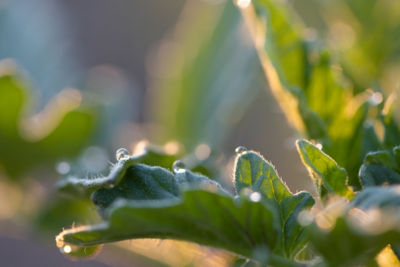Click here to download a PDF version of this spotlight
» Angular leaf spot, bacterial wilt, Phytophthora crown and root rot, and powdery mildew are important diseases on cucumber.
» Time of occurrence, severity, and the yield losses resulting from these diseases vary with geographic region.
There are many important diseases that damage cucumber plants resulting in significant yield reductions, but only a few of these are covered in this article. Additional information is available in the Seminis Cucurbit Disease Field Guide, which is available on the Seminis website.
ANGULAR LEAF SPOT
Angular leaf spot is one of the most widespread diseases of cucumber. The disease is caused by a bacterium, and the initial symptoms are small, water-soaked spots that develop on the undersides of leaves. These lesions expand until they become limited by the larger secondary veins in the leaf, giving the spots an angular shape (Figure 1). On susceptible cultivars, the spots may be surrounded by a yellow halo.1 Under humid conditions, a milky ooze exudes from the infected tissues. This ooze dries, leaving a white crust covering the lesions. The disease can also affect stems, petioles, and fruit. Fruit lesions are small (1/10th-inch diam.) and circular with light tan colored centers, and fruit will become deformed if infected when young.
 Figure 1. Symptoms of angular leaf spot. Gerald Holmes, California Polytechnic State University at San Luis Obispo, Bugwood.org.
Figure 1. Symptoms of angular leaf spot. Gerald Holmes, California Polytechnic State University at San Luis Obispo, Bugwood.org.
The angular leaf spot bacterium can be seedborne, present on transplants, and survive in the field on crop debris or volunteer cucurbit plants. The pathogen can survive in dry leaf material for up to two and a half years. The bacterium infects cucumber plants through openings, such as stomata, hydathodes, and wounds. The pathogen is spread by splashing water, insects, contaminated equipment, and workers. The disease spreads easily when plants are wet.1
The management of angular leaf spot begins with using pathogen-free seed obtained from a reputable source. Also, choose varieties that are resistant to the disease. Cucumber varieties with high and intermediate levels of resistance are available. Rotate fields to non-cucurbit crops for at least two years. Incorporate crop debris quickly after harvest to speed up decomposition. Avoid the use of overhead irrigation, and do not irrigate with water that may be contaminated with the bacterium. Keep workers and equipment out of fields when the plants are wet. The application of copper-based bactericides can help slow the spread of angular leaf spot; however, these applications may not be effective after the development of an epidemic. Treatments should begin when symptoms first appear, and the addition of an EBDC fungicide (such as mancozeb) will enhance the effectiveness of the copper treatment.1,2,3
BACTERIAL WILT
The bacterial wilt pathogen is transmitted by the striped and spotted cucumber beetles. The most critical infection period is from seedling emergence to the time when canopies start to close.2,4 Wilt symptoms can develop at any time, but the disease is most damaging early in the season when plants are growing rapidly.1 At first, only a few vines may be affected, but the symptoms can quickly spread to the entire plant. Eventually, vines become necrotic and die (Figure 2). A field diagnostic test for the disease involves cutting a wilted runner near the crown, pressing the cut surfaces together, and slowly pulling the pieces apart. If thin strands of bacterial slime form between the two cut surfaces, then bacterial wilt is probably the cause of the wilting symptoms.1 The wilt pathogen does not overwinter well in soil or crop debris. The bacterium most likely overwinters on weed hosts and volunteer cucurbit plants.
 Figure 2. Vine collapse from bacterial wilt. Gerald Holmes, California Polytechnic State University at San Luis Obispo, Bugwood.org.
Figure 2. Vine collapse from bacterial wilt. Gerald Holmes, California Polytechnic State University at San Luis Obispo, Bugwood.org.
Management practices for bacterial wilt focus on preventing feeding by cucumber beetles. Soil and foliar applications of systemic insecticides may be necessary in areas where the disease commonly occurs. Scouting for beetles should be done regularly, with applications beginning at the first sign of beetle activity.5 Soil applications are made at planting, followed by foliar applications beginning two to three weeks after transplanting or emergence.2 Other management activities should include the elimination of weed hosts and volunteer plants, rouging-out affected plants, and a two to three-year crop rotation schedule. Varieties with resistance to bacterial wilt are not currently available.
PHYTOPHTHORA CROWN AND ROOT ROT
Phytophthora crown and root rot causes damping-off of young seedlings as well as a rotting of root and crown tissues. A blighting of the leaves sometimes occurs. Plants develop a sudden and permanent wilt (not recovering overnight), and plant death can occur within a few days of the initial symptoms.1 A light to dark brown discoloration develops in the roots and lower stems. Affected tissues become soft and water-soaked. Eventually, the root system completely rots. The fungal-like pathogen can also cause a fruit rot, (Figure 3) with symptoms developing in the field or after harvest during shipment and storage.
 Figure 3. Fruit infected with Phytophtora capsici. Gerald Holmes, California Polytechnic State University at San Luis Obispo, Bugwood.org.
Figure 3. Fruit infected with Phytophtora capsici. Gerald Holmes, California Polytechnic State University at San Luis Obispo, Bugwood.org.
The pathogen overwinters in infested debris and on alternate hosts, including eggplant, pepper, and tomato.1 It is spread by splashing water and air currents. The disease typically occurs following periods of heavy rain or irrigation and in low or poorly drained areas of the field that remain wet for several days. Disease development is favored by soil temperatures above 65°F, air temperatures between 75° and 85°F, and extended wet periods.6
Phytophthora crown and root rot is managed through a combination of irrigation management, selection of sites with good drainage, crop rotation, sanitation, and possibly the use of fungicides. The disease is less likely to develop in systems using raised beds and drip irrigation. Prompt incorporation of crop debris after harvest and a three to four-year rotation away from susceptible crops will help reduce pathogen populations.1 Fungicide applications should begin at the first sign of the disease. A number of fungicides are available to control this disease. Varieties with resistance to Phytophthora rot are not currently available.
POWDERY MILDEW
Powdery mildew appears as a white, powdery growth on the upper and lower leaf surfaces (Figure 4), as well as on petioles and stems. Powdery mildew often develops first on older/lower leaves and on older, fruit bearing plants. Infected leaves prematurely whither and die. Cucumber fruit can also be infected by powdery mildew.1
 Figure 4. Foliar symptoms of powdery mildew.
Figure 4. Foliar symptoms of powdery mildew.
The pathogen requires a living host to grow and reproduce, and it does not survive on crop debris. In some areas, such as the coastal areas of California, the pathogen survives on cucurbit crop or weed species, and the disease can occur at any time of the year.7 In other areas, the disease develops later in the season, as spores are blown in from warmer areas. Spores can travel long distances in the wind and remain viable for up to eight days. The pathogen can also survive on plants growing in protected culture systems, such as greenhouses.1
Powdery mildew is favored by vigorous growth and dense plantings. Relative humidity levels between 50% and 90% are best for infection, but the presence of free moisture is not necessary. The disease can develop at temperatures between 50° and 90°F, with 68° to 80° being optimal.1
To manage powdery mildew, choose resistant cultivars when available. Varieties with intermediate levels of resistance to powdery mildew are available. Control weed hosts in areas where the pathogen can overwinter. Monitor the crop for the first symptoms of disease, at which time a fungicide spray program can be initiated.1,7 Resistance to certain fungicides has been detected in populations of the powdery mildew fungus in some areas. So, it is important to alternate applications of fungicides with different modes of action.2
SOURCES
1 Averre, C., Brown, J., Bruton, B., Chandler, L., Davis, R., and Duthie, L. 1996. Compendium of cucurbit diseases. American Phytopathological Society. St. Paul, MN.
2 Egel, D., Foster, R., Maynard, E., Weller, S., Babadoost, M., Nair, A., Rivard, C., Kennelly, M., Hausbeck, M., Hutchinson, B., Eaton, T., Welty, C., and Miller, S. 2017. Midwest vegetable production guide for commercial growers 2017.
3 Davis, R., Turini, T., Aegerter, B., Stapleton, J. 2016. Cucurbits: Angular leaf spot. UC Pest Management Guidelines. UC IPM.
4 Williamson, J., Doubrava, N., Blake, J., and Keinath, A. 2016. Cucumber, squash, melon & other cucurbit diseases. Clemson Cooperative Extension. HGIC 2206.
5 Williamson, J. and Griffin, R. 2016. Cucumber, squash, melon & other cucurbit insect pests. Clemson Cooperative Extension. HGIC 2207.
6 Davis, R., Turini, T., Aegerter, B., Stapleton, J. 2008. Cucurbits: Phytophthora fruit and crown rot. UC Pest Management Guidelines. UC IPM. 7 Davis, R., Turini, T., Aegerter, B., Stapleton, J. 2008. Cucurbits: Powdery mildew. UC Pest Management Guidelines. UC IPM.
ADDITIONAL INFORMATION
For additional agronomic information, please contact your local seed representative. Developed in partnership with Technology, Development & Agronomy by Monsanto.
Individual results may vary, and performance may vary from location to location and from year to year. The information provided in this communication may not be an indicator of results you may obtain as local growing, soil and weather conditions may vary. Growers should evaluate data from multiple locations and years whenever possible. ALWAYS READ AND FOLLOW PESTICIDE LABEL DIRECTIONS. The recommendations in this article are based upon information obtained from the cited sources and should be used as a quick reference for information about onion diseases. The content of this article should not be substituted for the professional opinion of a producer, grower, agronomist, pathologist and similar professional dealing with this specific crop.
SEMINIS DOES NOT WARRANT THE ACCURACY OF ANY INFORMATION OR TECHNICAL ADVICE PROVIDED HEREIN AND DISCLAIMS ALL LIABILITY FOR ANY CLAIM INVOLVING SUCH INFORMATION OR ADVICE. 161028155251 051617DME



